GOOD ROADS
The Award-Winning Magazine of the Arkansas Good Roads Foundation
White Hall Turns Infrastructure Development into Economic Growth




The Award-Winning Magazine of the Arkansas Good Roads Foundation
White Hall Turns Infrastructure Development into Economic Growth



It’s not just about getting from Point A to Point B. It’s about having the freedom to get out there, live your life, and make memories happen.
At Ergon, we’re proud to deliver the right paving, preservation, and maintenance and solutions designed to keep your road networks safe and strong. Because you have places to go and people to see. Don’t let inferior road conditions get in the way of life’s adventures.


White Hall: A Growing City Where New Infrastructure is Key Supporting a Military Mission
the
Crafton Tull Wins Award for Arkansas’ First SPUI Interchange at 71B / I-49
Four Arkansas School Districts Will Receive $11.03 Million from the EPA for Clean Buses











Robert Moery President
Lance Lamberth Vice President
D.B. Hill, III Secretary/Treasurer
Harold Beaver
Graycen Bigger
JoAnne Bush
Bob Crafton
Alec Farmer
Curt Green
Mark Hayes
Jerry Holder
Shannon Newton
Chris Villines
Jim Wooten
The Arkansas Good Roads/Transportation Council was established in 1975 as a 501(c)(3) non-profit, tax-exempt and tax-deductible organization. In 2015, the council was re-established as a foundation in order to be a more visible and credible voice on behalf of the mission of the Arkansas Highway Commission and the Arkansas Department of Transportation. The purpose of the foundation is to promote adequate funding and financing for the planning, development, construction, and maintenance of a safe and efficient highway, street, road, and bridge system, including transportation enhancements. The work increases statewide economic growth, private sector job creation and retention, and improves the quality of life in all Arkansas counties, municipalities, and communities.
Joe Quinn, Executive Director goodroadsfoundation@gmail.com
Kathryn Tennison, Editor kathryn@bestmanagement.net
Celia Blasier, Designer graphics@bestmanagement.net
















Joe Quinn, AGRF Executive Director
On a beautiful night recently, I was driving through White Hall as the sun started to set, and there wasn’t much passing traffic. It was a peaceful moment…a welcome break near the end of what had been a stressful week. As I drove past the little White Hall Museum, I saw a sign that caught my eye and pulled the car around to stop and look.
The fading words on the sign identified this road as a Blue Star Memorial Highway, A Tribute to the Nation’s Armed Forces who served in World War II. I was standing alone looking at the sign on the 80th anniversary of D-Day. Perhaps the most significant
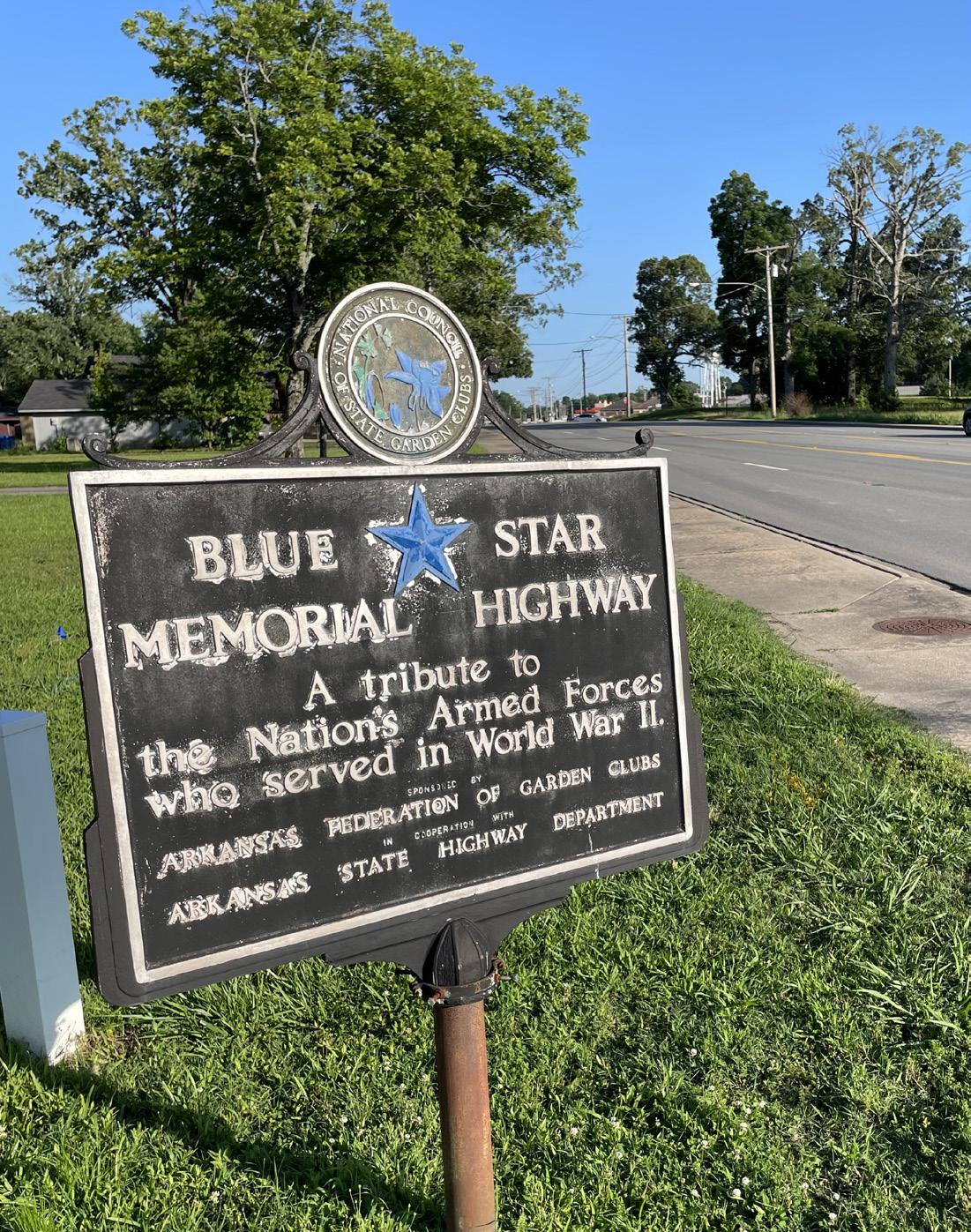
day in world history. The day Allied forces, under the direction of General Dwight David Eisenhower, began the Normandy invasion. If you were a 19-year-old in one of the initial landing boats to hit the beach, there was a 90% chance you would die that day.
The single age group that had the most American men fighting in the war was 19-year-olds. That statistic always makes me pause. They were kids, really, and they went to the other side of the world to liberate Europe, end the holocaust, and defeat Hitler. They came from a thousand American towns just like White Hall. Towns like this that made the guns, ammunition, and vehicles that won the war. Towns like this that grieved the loss of the men who never came home. A Federal Highway Administration article says the idea of designating roads to honor the Americans who served in the war started in New Jersey.
The Blue Star Memorial Highways are a tribute to the armed forces that have defended the United States of America. The National Garden Clubs, Inc., is the parent organization for Blue Star Memorial Highways.
The idea dates to 1944 when the New Jersey State Council of Garden Clubs beautified a 5½-mile stretch of U.S. 22 from Mountainside to North Plainfield.
Approximately 8,000 dogwood trees were planted as a living memorial to the men and women in the Armed Forces from New Jersey. The Blue Star, taken from the blue star in the service flag, was chosen to symbolize the memorial because it was used during World War II on flags and homes of families that had a son or daughter in the service. The New Jersey Legislature approved a Joint Resolution on January 22, 1945, designating this highway “Blue Star Drive.”
The idea that started in North Plainfield, New Jersey in the years after the war was embraced nationally, and 80 years later the sign still stands proudly beside the little museum at the side of the road in White Hall. The museum is freshly painted,
and monuments to the men who died later in Korea, Vietnam, and Afghanistan sit nearby. The grass is well-tended. There is nothing about the little museum and the sign on the edge of the road that would indicate this community cares any less about this country 80 years after D-Day.
It makes me proud to live in a state with towns where things like this still matter. In a country that spends time talking about what books should or should not be sitting on shelves in school libraries, we don’t seem to be spending much time teaching our children about World War II. But in the front yard of this modest museum, I am struck by the fact that multiple generations have cared for the monuments here for eight decades. Maybe we are actually passing the right history lessons down to our children.
You only really discover American history when
you get off the interstates and drive on the back roads that have been the lifeblood of our little state for so long. Roads with diners where you can still get a perfect cup of coffee and hear the complaints about the football coach. Roads that bring jobs and economic growth to towns like this. Back roads where you can still be reminded that 80 years ago today the boys from places like White Hall picked up arms to defend this amazing country.
Roads that carried the buses that took the local young men off to World War II and later brought some of them home. They came home and quietly built businesses and communities and created jobs, sat on school boards, and built a new post-war America. They were the greatest generation. Just ask the people who take care of the museum and the sign beside the road in White Hall.

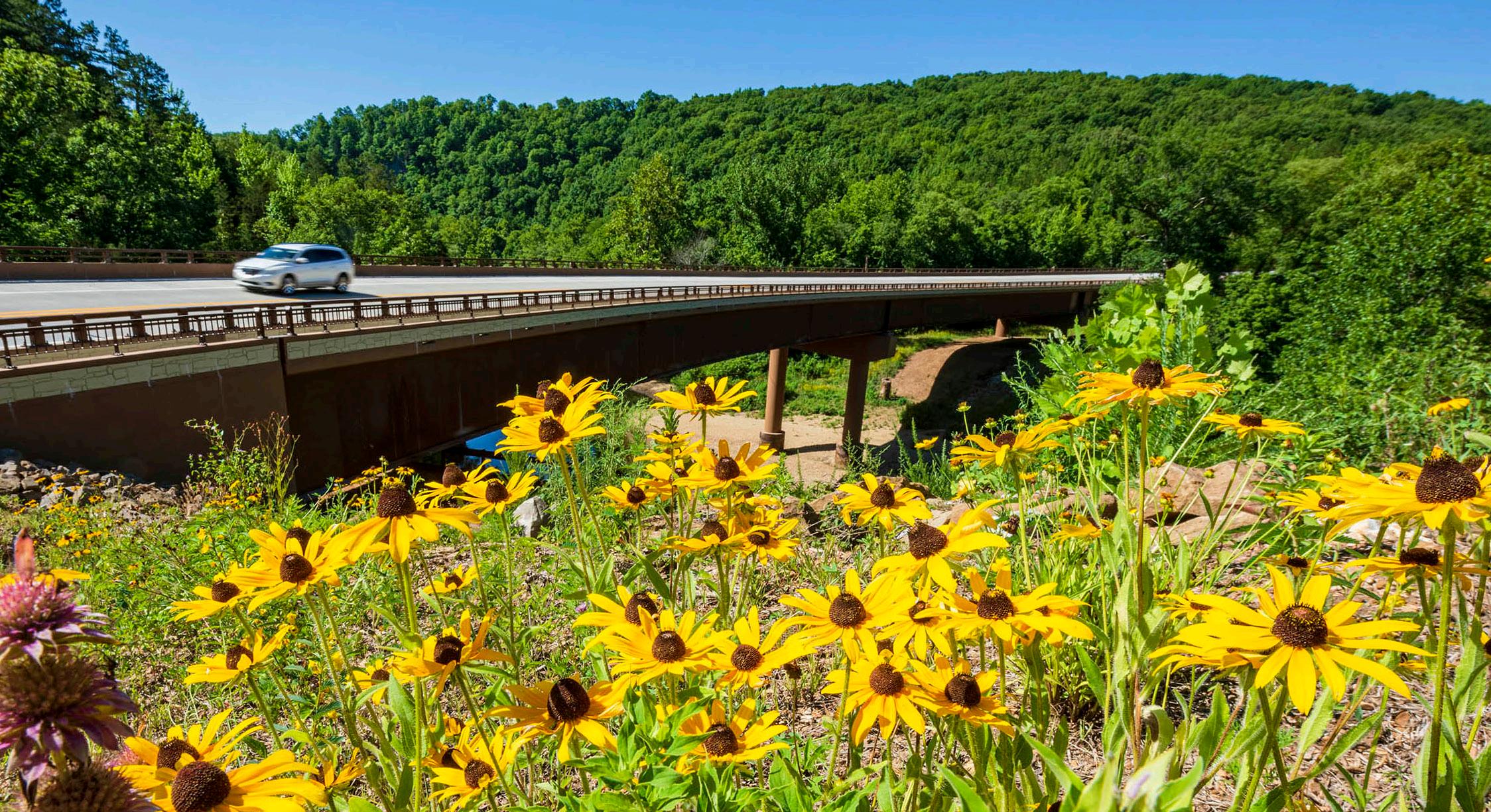
In the past 62 years, 70 Arkansas Department of Transportation employees have died while working. This is a number that includes both road workers and Arkansas Highway Police Officers.
ARDOT is in the process of designing a memorial to honor these men and women who came from large and small communities across Arkansas. We think this memorial will be a special place for families who sometimes feel that not enough attention has been paid to their loss. We could possibly break ground on the memorial before the end of 2024.
Anything you can contribute to the construction cost will be very much appreciated.
Please use the QR code below to donate.


It takes a moment for the eye to adjust to the sequence of names on the list of the 70 ARDOT workers who have died on the job since 1962. The year-over-year numbers get smaller as time passes. New safety policies ARDOT put in place, and more sophisticated equipment purchased to keep workers out of traffic, have reduced the frequency of deaths.
Twenty-five workers died working in the 1970s and five from 2000 to 2010. The list begins with a death in Texarkana on July 2, 1962. The most recent death was a worker in Little Rock on May 8, 2023.
There is a woman on the list who died on June 30, 2021. She was from Montrose. In North Little Rock in 1972 two fatalities came only six days apart. Two workers in Brinkley died on the same day on May 7, 1979.
As you look at each name you quietly wonder…were they a grandfather, did they coach Little League baseball, did they have a dog who greeted them at the back door each night after work, did they have a favorite family recipe served at Christmas, how long had they worked at ARDOT, and how old were they?
Working closely with ARDOT, Good Roads is helping raise the funding to build a memorial
to these workers. It will be on the grounds of the ARDOT headquarters in Little Rock. It will contain the names of each of the deceased workers, and we hope it will be a dignified, quiet place to reflect and think about people who are no longer with us.
No one donating to this noble cause cares if they get any credit for the donation. This is not about anyone getting credit, it’s about doing the right thing. Doing something long overdue.
Over the years, ARDOT would put the name of a deceased worker on an orange plastic cone and that modest display sat in a hallway at ARDOT. It didn’t feel right. It never felt like it was enough. And then ARDOT Director Lorie Tudor said quietly it’s time to fix this.
ARDOT employees participated in the initial design of the memorial. They created a rendering and then leadership at two large Arkansas engineering firms said, “What do you need from us? How can we help with the design?” Today the design work continues, and the hope is we can break ground on the memorial this year.
This is not about getting the memorial built quickly. It’s about getting it right. If you have donated to help with the memorial, a lot of good people are deeply appreciative. No taxpayer funds
are being used to do this work. No work is being done on state time. All of this comes from the heart. Everyone involved wants to get every small decision right, so the families of the deceased are shown the respect and love they deserve.
If you would like to donate, you can find out how to do so elsewhere in this magazine. If you have a loved one who died while working for ARDOT and somehow that person is not on this list, please call 479-426-5931.
Working on a busy roadway is never an uncomplicated way to make a living. The increase in distracted drivers with the invention of the cell phone made it more dangerous. When you are driving 70 miles an hour listening to music or talking to someone else in the car, the drive can seem peaceful. But, when you are standing with a shovel pushing hot asphalt, and traffic is passing at 70 miles an hour, you get a far better sense of the real nature of these jobs.
Our goal right now is to honor the deceased and their families who still think about the sad day when their loved ones did not come home from work. It is the least we can do.
Please look at the 70 names again and help us remember them. It is the very least we owe them.

Sam Carrigan Texarkana, 7/2/1962
James B. Webb Sheridan, 8/16/1963
Willis A. Earnest Prattsville, 8/16/1963
James A. Nichols Sheridan, 8/16/1963
Jackie L. Coffman Russellville, 9/20/1963
Wain O. Turner Osceola, 12/1/1967
John L. Phelan Little Rock, 6/30/1970
Carl G. Pitts Onia, 7/8/1971
Otto T. Utley Jacksonville, 2/25/1972
Orice R. Ward Batesville, 3/10/1972
Clarence Hobson N. Little Rock, 6/13/1972
Walter L. Gage N. Little Rock, 6/19/1972
Lewis B. Connell Leola, 9/19/1972
James A. Camp Wynne,12/12/1972
Curtis C. Rawls Rison, 1/2/1974
Jack E. Brockman Rosston, 4/5/1974
L.A. Daniels McCrory, 9/3/1974
Chester W. Darden Magnolia, 9/6/1974
Ancil Robison N. Little Rock, 1/9/1975
Billy C. Hyde Blytheville, 1/28/1976
Harden O. Garner Paragould, 6/9/1976
Virgil L. Green Pine Bluff, 7/12/1976
Ralph W. Wylie Gillham, 9/28/1976
Billy P. Godwin Alma, 7/29/1977
Daniel T. Dannelley Doddridge, 6/23/1978
Joe M. Burchfield Bismarck, 8/30/1978
David L. Truelove Conway, 2/17/1979
Roger D. Richardson Camden, 3/22/1979
Whipple H. Fields Brinkley, 5/7/1979
Oleather Swanigan, Jr. Brinkley, 5/7/1979
Jonathan I. Fish Junction City, 6/29/1979
Robert L. Andrews Magnolia, 2/25/1980
James E. Garner Wynne, 10/16/1980
Wesley C. Biggers Hampton, 1/28/1981

William O. Quinn Little Rock, 10/1/1981
Dale W. Wallis Bentonville, 4/18/1982
James A. Ralls Mena, 3/21/1984
Raymond O. Young Dardanelle, 7/31/1985
Lee O. Williams Magnolia, 5/12/1987
Herschel R. Harrison Sheridan, 7/29/1987
Michael A. Wolters Garfield, 10/31/1988
Marvin R. Sullivan Little Rock, 9/12/1989
Willie L. Hicks Little Rock, 4/16/1990
Gregory P. Martin Bryant, 6/13/1991
Bennie L. Walker Ozark, 8/20/1991
Billie D. Hensley Mountain Home, 10/10/1991
Lesley R. South Wynne, 12/23/1991
William R. Garner Fort Smith, 6/16/1993
Clarence R. Farmer Dogpatch, 10/9/1995
Ralph E. Buchanan Quitman, 3/7/1996
Glenn E. Page Atkins, 10/21/1996
Benny O. Malone Houston, 8/21/1998
Terrell D. Moore Waldron, 9/8/2003
Jerome Harris College Station, 1/16/2007
Russell R. Hightower Batesville, 3/19/2008
Bruce M. Fick Newark, 6/24/2008
Mark D. Abbott Conway, 5/7/2009
Joseph V. Pierson Mountain Home, 5/4/2011
Anderson D. Williams McGehee, 6/2/2011
Sharren S. Richards Van Buren, 5/1/2012
Anthony D. King N. Little Rock, 11/17/2013
John W. Garner Batesville, 8/5/2014
John E. Barefield Marvell, 9/17/2014
James K. Watts Marshall, 4/9/2018
Dorothy A. Hargraves Montrose, 6/30/2021
Isreal Meza Searcy, 8/4/2021
Matthew C. Moore Forrest City, 9/5/2021
Kurt J. Cottier Russellville, 12/19/2021
Winfred T. Petty Hensley, 1/18/2022
Timothy T. Harris, Jr. Little Rock, 5/8/2023
by Deborah Horn
From asphalt designed for smoother roads and wider shoulders to fog lines and rumble strips, the Arkansas Department of Transportation (ARDOT) has spent decades working toward building safer streets for the traveling public. Recently, they employed smart electronic technologies in that quest. The most recent includes Drivewyze, a traffic management system that alerts truck drivers to potential hazardous situations ahead.
Shannon Newton, Arkansas Trucking Association (ATA) President, was instrumental in bringing Drivewyze and ARDOT together last year. Drivewyze is an ATA member. Newton recalled that during early discussions, ARDOT Director Lorie Tudor “was impressed with their system, and she is always dedicated to making roads safer.”
In August 2023, the Arkansas State Highway Commission approved a partnership between ARDOT and the Drivewyze traffic management system. The commission voted to approve the system because it offered “information to on-road commercial drivers in real-time related to traffic situations ahead. It will be highly beneficial in reducing crashes and incidents.” The system costs the state about $225,000 annually but allows long-haul trucking companies and all truckers with a commercial driver’s license to utilize Drivewyze at no charge.
Joseph D. Hawkins, P.E., Assistant Division Head & State ITS Engineer for ARDOT’s Transportation Systems Management & Operations, said, “We’re excited about the system. The two services we currently use are the Virtual Sign Network and the
Congestion and Traffic Alerts.” An electronic on-board system or a free-to-download and use phone app alerts truck drivers to slowdowns or stops due to work zones or wrecks. Eighteen-wheelers approaching a traffic slowdown can’t get their rig — cab and trailer fully loaded is about 80,000 pounds — stopped in time, resulting in accidents.
Hawkins said, “These are often the cause of secondary crashes resulting in deaths because drivers aren’t expecting to stop on a rural highway or the interstate.” Unfortunately, at this point, on some roadways like U.S. Hwy. 65, Drivewyze can only provide static warnings of road hazards such as sharp curves ahead.
Shannon Newton says, “We want to utilize technology from an industry perspective. Our industry has prioritized safety and is investing in technology that benefits drivers.”
Hawkins said the highway department, like the Arkansas Trucking Association, is heavily focused on utilizing the latest technology to make the state’s roads safer.
According to Drivewyze, their system relies on geofences, which are virtual perimeters marking physical locations using GPS coordinates. A geofence can detect movement inside a boundary so a truck’s location triggers a service message without requiring roadside hardware. GPS-based driver messaging is delivered through existing telematics devices. IOTs (Internet of Things) refers to devices that rely on
electronic technologies to communicate.
The Drivewyze Safety Notification service, launched in 2018, is designed to provide critical information to CMV drivers. Since then, the company, headquartered in Canada, has launched Smart Roadways, which allows state agencies to work with Drivewyze to provide safety-critical messages to drivers operating in their state.
“We’re excited about the system. The two services we currently use are the Virtual Sign Network and the Congestion and Traffic Alerts.”
— Joseph D. Hawkins, P.E., ARDOT Transportation Systems Management & Operations
It’s the largest network of connected trucks in North America, the company said.
“First, we identified all major roadways that the system could utilize,” Hawkins said. Then, they started entering the necessary information to make the system functional for their purposes.
Hawkins said it has three main components or features. The Congestion and Traffic Alerts rely on information from real-time traffic data, while the Virtual Static Roadside Signs are based on 71 nonchanging signs. The third, Virtual Dynamic Message Signs (DMS), utilizes 180 Virtual DMS locations that ARDOT established around the state.
These were designed “to complement our current 65 ‘Real’ DMS across the state,” Hawkins explained.
ARDOT staff can analyze data such as Alert Counts by month, day, hour, and incident duration through its CMV Traffic Alert Dashboard-AR and identify the most active corridors. For example, during February,
there were 3,876 total Alerts with 2,870 total Vehicle Aerts – not every Alert goes out to every participant.
Inside the Cab Drivewyze utilizes commercial motor vehicles (CMV) and electronic logging devices (ELDs) located in the cab. These are required for long-haul trucks that travel more than 100 miles from their point of origin. In January, Drivewyze announced the launch of a free service, Drivewyze Free, for drivers who travel fewer than 100 miles daily. This service delivers in-cab safety messages to all fleets and commercial truck drivers using telematics devices such as tablets and smartphones to receive essential in-cab safety alerts and advisories.
Mike Brust, Director of Safety & Loss Prevention for the Arkansas Trucking Association, said, “Drivewyze is a great partner and member of our association. John Van Nortwick from Drivewyze spoke at our fourth-quarter Safety Management Council meeting in December 2023. I know of a few trucking companies that have informed their drivers


about the free version of Drivewyze.”
The alerts are specific to certain areas instead of a wide net of alerts being cast. Hawkins explained, “Drivewyze doesn’t overuse the system. If it’s not about your location, you tend to tune it out. We wanted to make sure that the message was personalized. That way, drivers don’t tune out the alerts.”
According to Drivewyze, “Smart Roadways alerts keep drivers informed in real-time about traffic and congestion events occurring in Arkansas while allowing drivers to stay focused on the roadway.” These alerts will allow drivers to make wise decisions based on real-time information as they approach highrisk zones and give them extra time to take preventive measures.
In late 2023, a TRIP report titled “America’s Rolling Warehouses: Opportunities and Challenges on the Nation’s Freight Delivery System” indicated that extensive truck travel is up in Arkansas. It also ranks the state as fourth nationally in fatalities per 1 million miles driven by all vehicles. Between 2017 and 2021, there were 91 people killed in crashes involving trucks, with 67 of those victims being drivers in other vehicles like passenger cars. Hawkins said, “Often when a passenger vehicle engages with an eighteenwheeler…It can be devastating.”
But that’s only about one-seventh of all vehiclerelated fatalities in Arkansas. According to a 2021 Arkansas State Highway Safety Report, about 693


died that year in traffic wrecks.
Through technology such as Drivewyze and the planned installation of 156 Wrong-Way Detection Systems, ARDOT is attempting to reduce the state’s accident fatality rate. Hawkins said these systems can help “keep our roads safer for all drivers.”
For more information about Drivewyze or Drivewyze Free, go to drivewyze.com or drivewyze. com/blog/press-release/drivewyze-free-safety-servicelaunch/.

Currently, Drivewyze is being utilized on some sections of interstates 630, 555, 530, 440, 430, 67/167, 55, 49, 49/549,40, and 30, and U.S. highways 67/167, 82, and 612.





by Deborah Horn
White Hall city officials welcomed a new 87,000 sq. ft. Jefferson Regional Specialty Hospital in May, the latest of many recent groundbreakings, grand openings, and home starts. This is another concrete sign that the small city, with a population of almost 6,000 and once considered “just” a bedroom community of Pine Bluff, is coming into its own.
Mayor Noel Foster took office in 2011, and before that, he served as the city’s Police Chief. During an Arkansas Good Roads Magazine interview, he said, “White Hall has dramatically changed over the last two decades.”
He points to the construction of Interstate 530 in the late 1990s, coupled with the former administration’s strategic planning around that road construction, as having had a “major impact” on the city’s growth. The interstate paved the way for business opportunities like hotels, gas stops, and, at first, fast-food restaurants and convenience stores. However, it’s now a hub of extended-stay facilities, corporate headquarters, various sit-down eateries, and a half-dozen new banks, food markets, and retail shops.
Sheridan Road is so busy that businesses like White Hall Fresh Market and Sylvia’s Pizzeria are opening on the Pine Bluff side of the street, where the two towns join, about a mile east of Exit 34. Both business owners considered it a prime location.
I-30’s Exit 34 wasn’t much more than a gas station and a few fast-food options back then. Still, when former White Hall Mayor James “Jitters” Morgan, now deceased, talked of the benefits of a business located there, he touted White Hall’s proximity to the interstate, running just west of town, as easy and
quick access to the state’s major north-south and eastwest interstates, the state Capitol and the Little Rock airport, and transportation options that include truck, rail, and river.
While its population has slowly increased, numerous large and small companies saw it as an opportunity. They built or relocated there, and it was a plus for the Pine Bluff Arsenal as they started destroying the nation’s chemical stockpile stored there.
Better roads and infrastructure in this area have made it easier for traffic to get to the historic Pine Bluff Arsenal, just across the city line from White Hall. For several years, political and community leadership in White Hall have been thoughtfully evaluating how better infrastructure drives the local economy.
As many Pine Bluff employers shuttered their businesses in the 1990s and 2000s and Southeast Arkansas’s largest city’s population continued to shrink, losing about 10,000 residents from 2010 to 2020, it could have crippled White Hall, Foster said. But people who once looked for work in Pine Bluff suddenly realized that a twenty-minute drive to Little Rock made employment a viable option while continuing to live in White Hall.
The easy drive gave people a more comprehensive array of employment options and kept many people from leaving the city, while others, such as Doris Golden, saw White Hall as a place to aspire to live.
It continues to rank as one of Arkansas’s top cities, ranking low in crime and high in public school quality, and Foster said, “We’re focusing on improving the quality of life for our residents.”
Golden is Jefferson County 911 Operation Manager
Opposite page: The Jefferson Regional Hospital opened recently and is expected to contribute to economic development in the Exit 32 area off I-530. Better roads in any town make it easier for emergency vehicles to get people to medical care.
who moved to White Hall four years ago. It was her dream, she said, adding, “I love the feel of the closeknit community. It’s quiet, serene.”
New home starts have been brisk over the last few years, and Foster added, “Right now, I have a proposal for a 10-home mini subdivision on my desk.”
Two years ago, Foster asked Golden to serve on the city’s Planning Commission. Golden said, “It was something I was interested in pursuing. I see it as a very exciting time in White Hall. Growth is happening at a rapid pace.”
She and others would like to see the opening of a big box store like Walmart or Target.
Times have changed, and according to 2022 traffic count numbers, I-530’s exit 34 accommodated about 27,000 vehicles per day, making it one of Jefferson County’s busiest intersections. In part, it prompted ARDOT to realize the crucial need to widen Sheridan Road, and Foster added, “This area is one of the most congested areas in the city.”
The widening of Sheridan Road will extend approximately two miles on either side of Interstate 530, exit 34. It will extend from the intersection of U.S. Hwy. 270 and Ark. Hwy. 365-S to Arkansas Hwy. 104 to Hwy. 365. The existing two-lane roadway will be widened to four lanes with a center turn lane, and curbs, gutters, storm drains, and sidewalks will be added along both sides of the highway. In 2022, ARDOT estimated the project would cost about $20 million.
“It’s expected to alleviate the traffic problem in this area,” and Foster sees it as an opportunity for additional growth. The widening and sidewalks will change the whole area, and Foster said it’s been instrumental in convincing businesses to invest in this area.
What sets the hospital opening apart is its location. Most of the recent growth has taken place on the more southwestern end of town, but it’s located on the northwestern end at I-530’s Exit 32.

The exit has long served the Pine Bluff Arsenal and now the White Hall School District’s high school. Traffic is congested before and after school, but nothing like after football games or graduation. But unlike Exit 34, it’s seen less development. White Hall City Council Member David Beck said that “may change.”
The hospital is expected to employ as many as 200 people, and that doesn’t include visitors. The Jefferson Regional White Hall complex is also home to the Jefferson Regional Wellness Center, which houses a workout facility, breast center, and more. Nearby property is zoned commercial, and the city has already had inquiries about building there.
“White Hall is coming into its own,” Beck said. He has served on White Hall’s City Council since 2001, and he currently serves as Co-Chairman of the Military Affairs Advisory Committee (MAAC), an Economic Alliance of Jefferson County Board Member, and a Chamber Member. He said it didn’t happen overnight and credits I-530 as a critical factor.
“Good roads are critical to economic development, and their importance can’t be overstated. Without them, an area can’t be economically viable,” Beck said.
Morgan also saw Interstate 530 as a growth opportunity for the city, and it did. The initial growth was instrumental in funding a sizeable modern community center, growing the city park and a sports complex, and eventually opening the Crenshaw Springs Water Park. It now attracts folks from around the state and surrounding states and fills its hotels and restaurants.
Beck said, “The highway department laid the roadwork for much of this growth.” Foster is quick to point out that Morgan and the Council Members took advantage of the economic and growth opportunities afforded to the city. Foster added, “They laid the foundation for the boom we’re experiencing now. We’re building on their legacy.”



by Deborah Horn

As the Pine Bluff Arsenal fights to retain its viability as a military institution, infrastructure improvements and upgrades are believed to be key. One critical component that needs a redo is the widening of the two-lane Arkansas Highway 256 and the replacement of its more than 80-year-old Caney Bayou Bridge, according to a Compatible Economic Development Assessment Report (CEDAR) presented in 2022.
The bridge wasn’t built to handle modern traffic weights or demands, and frequent flooding makes it more hazardous. An estimated 1,000 commercial and passenger vehicles drive across it daily. It’s vital to the long-term success of the Arsenal’s mission.
It’s estimated that upgrading that approximately two-mile stretch of road, including the bridge replacement, will cost about $9.8 million.
They haven’t secured the total funding needed, but
the Arkansas Department of Transportation (ARDOT) is already on the job.
Prior to 2010, the PBA employed about 2,000 in the destruction of its chemical weapons and other military-related manufacturing operations, but the number has dwindled to about 740 – a drop of almost two-thirds – and the post’s closure isn’t out of the question, some believe.
White Hall Mayor Noel Foster likens it to the Little Rock Air Force Base at Jacksonville.
He said, “When it was named the Pine Bluff Arsenal, its namesake was the nearest city, which is about eight away.” The Arsenal’s perimeter butts up against White Hall, founded in 1964, and continues to be one of its largest and best-paying employers. The Arsenal helped White Hall become what it is today.
U.S. Army Col. Tod Marchand, then the arsenal’s commander, said at the time of CEDAR’s release, closure would be like “a bomb going off.”
The study estimated that 951 direct, indirect, and induced jobs are created by the industries located on the post. It generates an annual payroll of about $62 million and spends about $96 million, about 60 percent, locally and around the state. In addition to layoffs, local businesses like gas stations, grocery stores, and restaurants would be impacted.
Foster said, “The economic impact is eyeopening…and to realize the fallout if the Arsenal closed.” Beyond the personal income, sales, and property taxes needed to support the county’s municipal governments and school districts, he said, “This is a legacy workforce, and if the Arsenal went away, White Hall would lose its best recruiting tool.”

According to Cheryl Avery, a PBA civilian spokeswoman, approximately 1,000 civilian and military employees and personnel enter the Arsenal daily, with about 11,000 tons of shipments coming and going annually.
There are two entrance points, but neither is fully suitable for the Arsenal’s needs. Currently, the Dexter Gate entrance is the only one that can be used by commercial vehicles, but the street-level railroad crossing makes it a hazard. Larry E. Wright, P.E., LE Wright & Associates, PLLC, said about the Dexter entrance, “It’s a mess.”
Mayor Foster was behind the formation of a 26-member committee comprised of local economic groups and governments about seven years ago, and Wright, White Hall’s Consulting Engineer, serves as the Grant Project manager on the committee.
Wright said the Plainview Gate is considered a safer entry option because of the elevated viaduct that crosses over the railroad tracks; however, the two-lane Hoadley Road that leads up to the gate isn’t adequately able to handle the volume of commercial and passenger vehicle traffic without a major road upgrade and the replacement of the Caney Bayou Bridge.
From I-530 to a curve in the road near the White Hall School District Administration Building, Hwy. 256 is known as Holland Road, after which and heading east, it becomes Hoadley Road. The proposed road rehab includes both sections of road. According to Taylor Clark, PE, McClelland Consulting Engineers, Inc. of Little Rock, the Holland Road section would require an asphalt overlay, and ARDOT has that work on its scheduled docket.
His team did the Hwy. 256 survey and geotechnical work in late 2021 and spent the first eight months of 2022 working on the different design options. Holland Road is a relatively easy fix, while Hoadley Road is more complicated and ultimately more expensive, Clark added. Hoadley Road has short shoulders, and it crosses Caney Bayou by way of Bridge #2280.
Because of flooding, the entire existing roadway elevation will be kept as much as the geometry allows. As for the roadway itself, Clark said, “The goal was to minimize its footprint.” To meet this end, his team decided to use the existing roadbed but noticeably widen its shoulders to 8 ft. on each side with the more gentle slope as currently favored by ARDOT.
Hoadley Road’s resurfacing will cost an additional $3 million. The project will also include a number of

Looking towards Pine Bluff Arsenal’s headquarters building during a snowstorm in the 1970s.
soft costs such as utility relocation, property right-of-way purchases near the bridge site, its installation, money to help with the move of the old bridge, and more.
The Bridge Rehabbing the WWIIera bridge would be greater than the cost of building a new one. Clark said, “Bridges built during the World War II era fall short of modern weight and engineering standards.” Also, today’s vehicles, both family and
“The economic impact is eye-opening…and to realize the fallout if the Arsenal closed. This is a legacy workforce, and if the Arsenal went away, White Hall would lose its best recruiting tool.”
—White Hall Mayor Noel Foster

For Now
ARDOT has approved the Hwy. 256 work, said Dave Parker, ARDOT spokesperson.
“The contractor has started work on the guardrails for the bridge structure between Dollarway Road and the Arsenal.”
The road rehab begins at Dollarway and Hoadley roads and stops at the viaduct (railroad overpass) near the Plainview entrance. It will receive cold milling of the existing pavement, a 2” overlay, and the addition of 2-ft. shoulders on each side of the roadway.
The contractor will complete the road improvements this summer after the current school
Wright said, “ARDOT is doing safety enhancements to the bridge and the road in the interim, and we appreciate that.” Still, their long-term goal includes additional upgrades.

Natural State Consulting and Strategies is a Little Rockbased firm that has recently taken over the communication and lobbying work for the Arkansas Chapter of the American Concrete Pavement Association. Tyler Lachowsky is serving as Arkansas Promotional Director for the concrete industry, he says,
“The goal right now is to build and rebuild relationships in the Arkansas infrastructure world. We want more engagement with ARDOT, contractors, and other key players who are involved daily in road construction.”
ACPA has long been a Good Roads member, and now to better engage on this issue, and serve concrete contractors and manufacturers, Natural State Consulting has joined the Good Roads effort.
Lachowsky says the concrete industry is facing multiple key issues, and to push the industry message to political and community leaders, the concrete sector of the economy needs to be more visible. In the post-Covid world, visibility for any effective trade organization means a digital strategy, a daily effort to build relationships, strategic donations, and thoughtful use of funding provided by members. It also means creating understandable messaging that makes sense to audiences outside of the insular world of people in infrastructure development.
One of the main focus areas for the concrete community in Arkansas is meeting the state requirements for performance engineered mixtures. Lachowsky says, “Using concrete mix designs that are based on performance has several advantages, such as improved durability, environmental benefits, and overall cost-effectiveness. The specification team at ARDOT has
been cooperative and receptive to our perspective on issues like this. Having good relationships is the key to navigating an issue like this in a way that leads to both better and more cost-efficient roads.”
As more funds are allocated to road construction projects from both state and federal sources, it’s vital to have a strong, competitive pavement market to make the most of these funds. There are 3.9 million miles of roads in the United States today, with three million miles of those roads located in rural areas, only 1.2% of the current roads across the country are interstate highways.
But the positive news for all Arkansas road contractors is that nationally the number of jobs created by all road and bridge builders is up roughly 7% from where it was a year ago. Lachowsky is enthusiastic about being another voice supporting infrastructure improvements in Arkansas. He recently told Good Roads, “What’s clear right now is that all of us working together cohesively means more business for all sectors of the economy, safer roads, and economic development in small and large communities. Our members are eager to engage in this larger effort to tell our story in a meaningful and effective way.”
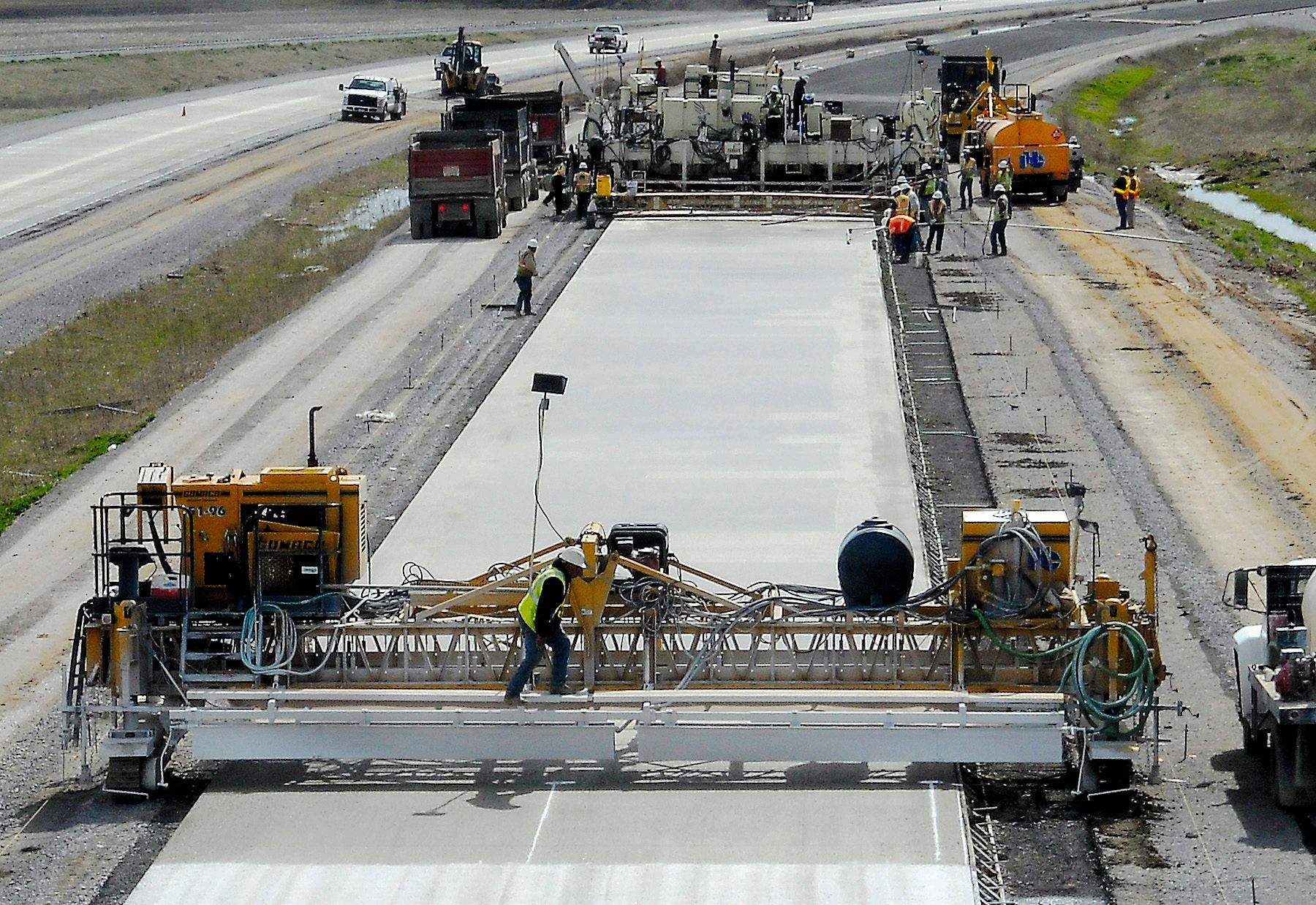





By Joseph Jordan, Advanced Geospacial Specialist, Planning Division, and David Nilles
(Reprinted with permission from
ONE OF THE FIRST STEPS TO MANAGING ANY RESOURCE, IS TO TAKE AN INVENTORY.
It’s very difficult to effectively steward a group of assets if you don’t know how many you have, what kind they are and where those assets are located. Through the years that inventory, and the information it contains, forms the baselines for evaluating performance measures. How else can we know if we are achieving what we set out to do as an organization? Peter Drucker, who wrote much on business management in his lifetime said it well: “What gets measured, gets managed.”
At ARDOT, we have many assets to manage across the state. The first that comes to mind is the 16,400+ miles of highway and 7,300+ highway bridges that we work tirelessly to maintain to the highest standards. Combined, these form the core foundation of the state’s highway system—so it’s no wonder they get so much attention. But from traffic signals, to cameras, to message boards, to guardrails, there are many more components that work together to make that system safe and efficient.
Possibly the largest most dynamic asset group out of all of these is our signs. Even with advances in technology, signs are still the number one way to quickly communicate information and hazards to drivers on the road. Currently, we have nearly 600,000 documented signs, and over 300 individual types of signs categorized.
ARDOT)
While the concept of a “sign inventory” is nothing new, a centralized digital database, outside of handwritten paper logs, has been a long time coming. The current handwritten inventory system has done the job for years; however, it hasn’t been a system where information can be gathered quickly. The challenge of not just collecting this vast number of highly varied assets, but also validating them, and keeping them up to date as signs are constantly installed, removed or replaced all over the state is a daunting one, to say the least.
In 2020, the decision was made to move forward with collecting images and basic attributes for all highway signs on the state highway system. In a partnership between the Maintenance and Planning divisions, a plan was devised to use imagery captured by the Department’s Automatic Road Analyzer (ARAN) to get an initial sign inventory from the images. After that, a digital application called Esri Quick Capture was developed to log images of sign installations, removals and replacements occurring across the state.
In late 2022, the District 7 Sign Crew was the first to test the new system that currently provides real-time images of all sign work in the region.
They simply click a button on the iPad to correspond with the work they are doing whether it be sign installation, sign replacement, sign removal or several other choices. “Safety is the key,” stated Sharon Hawkins, Staff Graphic Information System
(GIS) and Mapping Administrator. “We don’t want crews out on the road any longer than they have to be. They hit the appropriate button on the iPad, then back up and take a picture of the sign. All of this can be done in 5 to 10 seconds.”
Chase Arnold, District 7 Sign Crew Supervisor, has been impressed with the new system’s performance out in the field. “Capturing the data is really easy and simple,” he shared. “It only takes a few seconds per sign, and we’ve had no problems using the program.”
Once the data is loaded into Esri, it rolls into a staging area. Joseph Jordan, Advanced Geospatial Specialist, Planning Division, oversees the database. With the help of ARDOT Geospatial Specialist Mark Jaeger, they look at the information, verify it and post it to the database.
“District 7 has been using the system for over a year,” stated Hawkins. “There have been over 1,500 sign changes in District 7 in that time, so just imagine what that means as Districts across the state begin collecting. The Statewide Sign Crews and District Sign Crews are going to be a big part of this process and their work is how this new digital inventory is going to work and be successful.”
“While it has been an enormous undertaking to collect, process and plan maintenance for, the return from the sign database has been incredibly valuable,” Jordan shared. “The database can be accessible online to everyone at ARDOT from entry level planners to executive level decision makers, in a format where they can visualize, filter and draw insights to make the best data-driven decisions possible at the time.”
And while sign locations themselves are valuable, this is only the beginning of how the sign data can be used. “The speed limit signs are now used to maintain a statewide speed zone dataset that aids in decisions where speed limit is a critical factor,” Jordan shared. “We use it for all kinds of analysis. For example, where can centerline rumble strips go within these parameters? We are also able to see where interstate mile markers align or deviate from their intended locations. We can even plot out stretches of highways that have been adopted for volunteer litter cleanup through the state’s Adopt-A-Highway program and pinpoint locations that still need volunteers. Though we are not there yet, a digital
sign database could one day help us move beyond hand-written paper logs and provide us with a foundation for a full-life-cycle sign management system.
These are just a few ways we are putting the sign database to work for us in practical and meaningful ways.”
As ARDOT discovers new ways to put the sign database to work, other Departments of Transportation (DOT) are watching.
“We’re excited to compare notes and lessons learned,” Hawkins shared.
It would be a mistake, however, to think that ARDOT’s most valuable asset is its highways, bridges, signs or even its impressive library of data. ARDOT’s most valuable assets will and always will be its people. While the sign database has great potential to revolutionize the way we manage sign assets and make decisions, it’s not perfect. Even after much investment — the sign database will only be as good as its contributors make it. Ultimately, success to the greatest potential lies in folks across many divisions and work groups coming together with a shared vision. Not just to comply with directives, but to truly see the value in the effort and prioritize stewarding our organization’s digital data repositories with the same vigor we do our physical, tangible assets. And not so that it can just sit there, but so that we can consistently utilize it to empower and equip our leadership at all levels to make the best judgment calls they can.


6,000
The population of White Hall today.

27,000
The number of vehicles I-530’s exit 34 accommodates per day, making it one of Jefferson County’s busiest intersections.



$20M
Estimated cost to widen Sheridan Road about two miles on either side of Interstate 530, exit 34. The existing two-lane roadway will be widened to four lanes with a center turn lane.
$9.8 M
Estimated cost of upgrading Arkansas Highway 256 and replacing its more than 80-year-old Caney Bayou Bridge...total funding has not yet been secured.
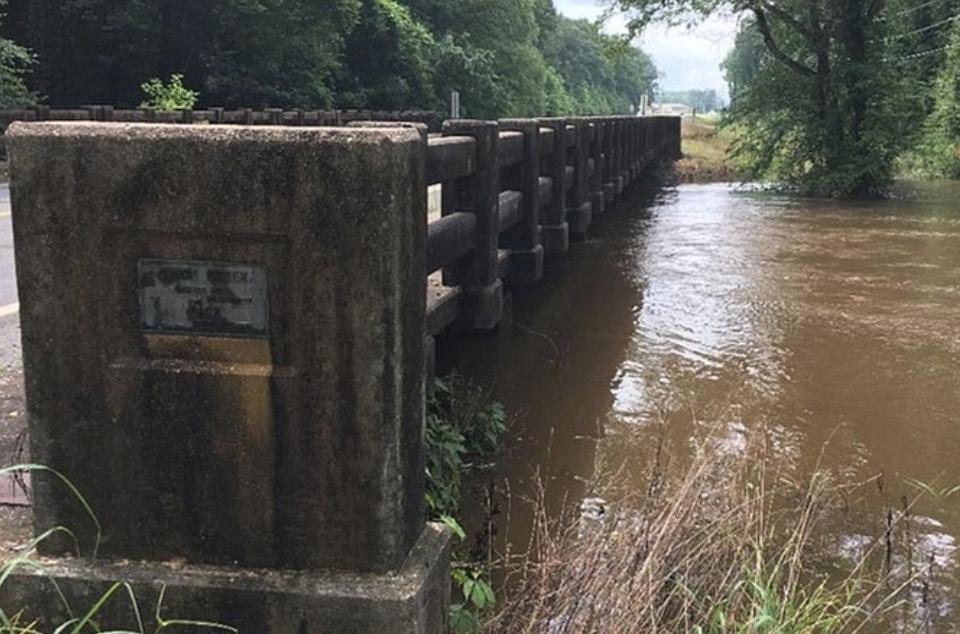
951
The number of direct, indirect, and induced jobs created by the industries located on the Pine Bluff Arsenal. It generates an annual payroll of about $62 million and spends about $96 million, about 60 percent, locally and around the state.
1,000
The number of civilian and military employees and personnel who enter the Arsenal daily, with about 11,000 tons of shipments coming and going annually.

1.5 million
The estimated cost to replace WWII era Bridge #2280 on Hoadley Rd. (not including installation) which crosses the Caney Bayou.

1,500+
The number of signs that were installed or replaced by the District 7 Sign Crew in 2023, including: 10 AdoptA-Highway signs, 31 Speed Limits, 8 Yields, 114 Stops, 9 Bridge Ices Before Road, and 366 Chevrons.



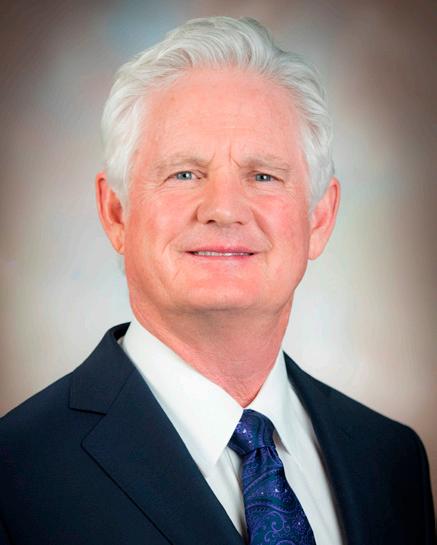

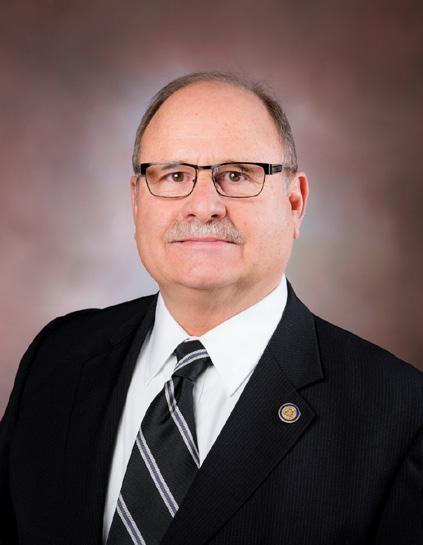












ACEC/A & ASPE
American Concrete
Pavement Assoc. OK/AR
APAC-Tennessee
Atlas Asphalt, Inc.
APAC-Central
Arkadelphia Alliance
Arkansas Concrete
Arkansas Farm Bureau
Ash Grove Cement
Bank of Delight
Clark Machinery
Commercial Bank - Monticello
Contractor’s Specialty Service Co.
Cowling Title
Crisp Contractors










The Cashion Company
CPC Midsouth
Emery Sapp & Sons
First Community Bank of Batesville
Golden Triangle Economic Development
Jeffrey Sand Company
McGeorge Contracting Co.
Michael Baker International
Dermott Industrial Dev.
Duffield Gravel Company
Dumas Chamber of Commerce
Eagle Bank and Trust
Fayetteville Chamber of Commerce
FM Structural Plastic Technology
Forsgren, Inc.
Hines Trucking Inc.
Horatio State Bank
I 49 International Coalition
Jack Buffington
LaCroix Optical Company
Larco, Inc.
Lawrence Co. Chamber of Comm.
M & T Paving and Construction
Maxwell Hardwood Flooring
Midwest Lime Company
Mobley General Contractors
Monticello Econ. Dev. Comm.

Natural State Consulting and Strategies
NWA Council
Riceland Foods
Rogers Group
Walmart
NEA Intermodal
Ohlendorf Investment Co.
Paragould Regional Chamber
Pickering Firm
Razorback Concrete
Riggs CAT
Ryburn Motor Company
Scott Equipment
Springdale Chamber of Comm.
SW AR Plan & Dev. District
UCA Foundation

At the 2024 American Council of Engineering Companies of Arkansas (ACEC) Engineering Excellence Awards Gala, Crafton Tull won the Grand Conceptor Award for their work on the state’s first single-point urban interchange (SPUI).
What is an SPUI? Mike Burns, Crafton Tull executive vice president, explained that an SPUI allows one signal to control the flow of traffic coming from both exit ramps and through traffic. Because there are fewer traffic lights, there’s less risk of accidents, and traffic flows more smoothly. This is in
contrast to a diamond interchange, which usually has two traffic lights.
The SPUI is located at the Interstate 49/U.S. Highway 71 interchange in Benton County.
According to the Crafton Tull website: “This project increased capacity at a busy interchange that connects two cities, widened a federal highway bridge, reconfigured traffic flow on the state highway below, and modified two city intersections near the highway.”
Construction began in September of 2018; the SPUI opened in 2023.
The U.S. Environmental Protection Agency (EPA) has announced that, through the 2023 Clean School Bus Program, four Arkansas school districts will receive a total of $11,030,000 in order to purchase clean school buses (mostly electric).
• Quitman School District - $820,000
• Little Rock School District - $8,625,000
• Batesville School District - $365,000
• Farmington School District - $1,220,000
These new buses will replace diesel-fueled school buses that are linked to asthma and other harmful
conditions that can affect students. They will also produce lower tailpipe emissions.
“This announcement is not just about clean school buses, it’s about the bigger picture,” said EPA Administrator Michael S. Regan. “We are improving air quality for our children, reducing greenhouse gas pollution and expanding our nation’s leadership in developing the clean vehicles of the future.”
According to the EPA, to-date they have awarded just under $3 billion to fund around 8,500 new school buses.
The Arkansas Department of Transportation (ARDOT) launched an interactive dashboard designed to keep citizens informed about pavement conditions across the state, the status of construction jobs, safety data, and other metrics under the “Transportation Performance” umbrella.
The Transportation Performance Dashboard can be accessed via ARDOT’s website at ardot.gov/ performance.
The dashboard features gauges showing bridge condition, Interstate condition, and National Highway condition ratings – along with the evaluation process and what each rating means.
“These ratings are determined using federal standards,” said ARDOT Director Lorie Tudor.
“Seventy-five percent of our budget goes toward taking care of the roads we already have. We’re proud of our pavement preservation efforts across the state and are excited to have a tool that shares where we stand in that continuous effort.”
The dashboard also includes the latest roadway safety data and an interactive map of construction jobs across the state.
“This is a great tool to promote transparency and show the public how their tax dollars are being spent,” said Director Tudor. “We hope to continue adding features to this dashboard over time.”
Additional travel information can be found at: IDriveArkansas.com or ARDOT.gov.
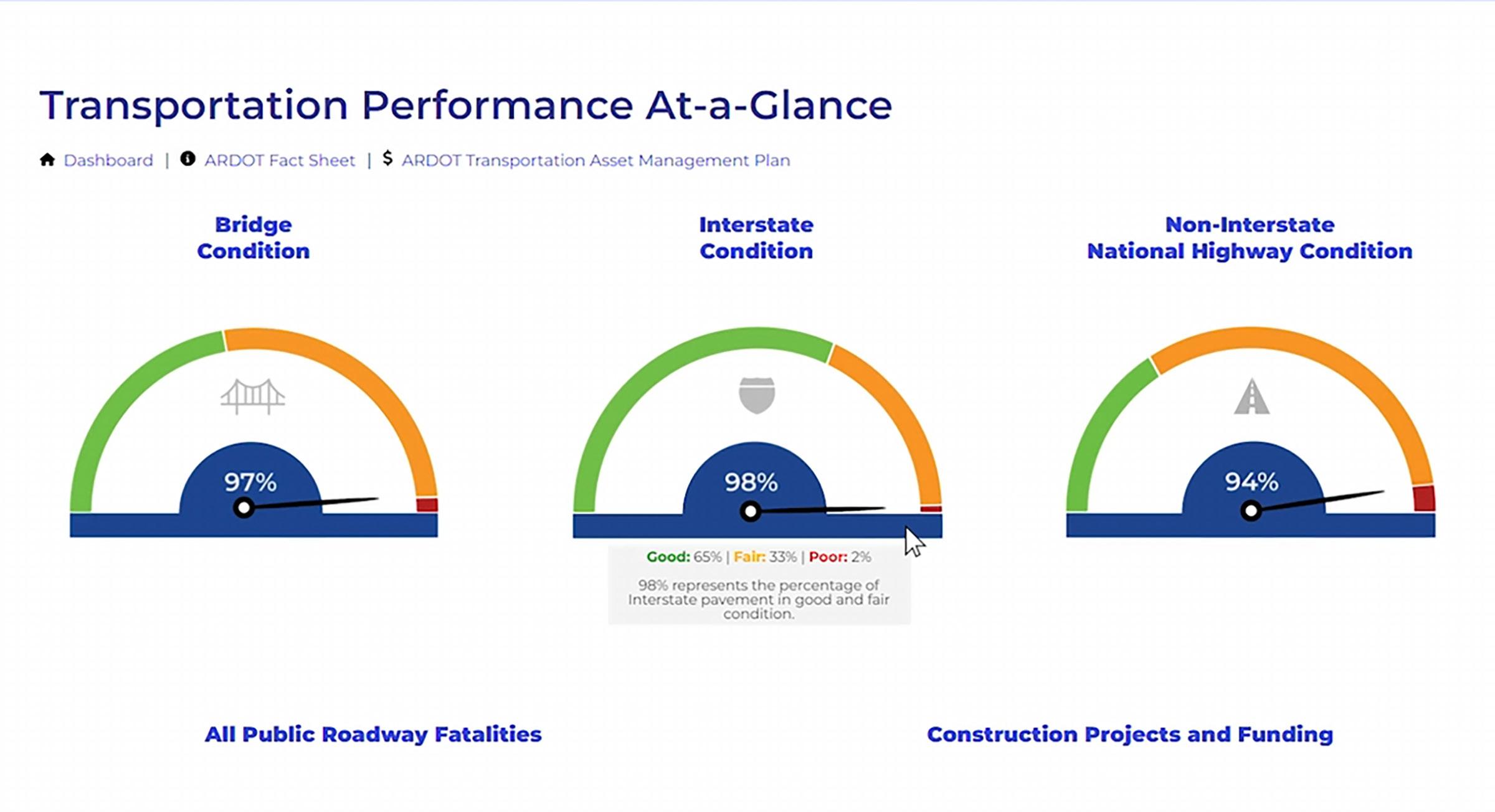
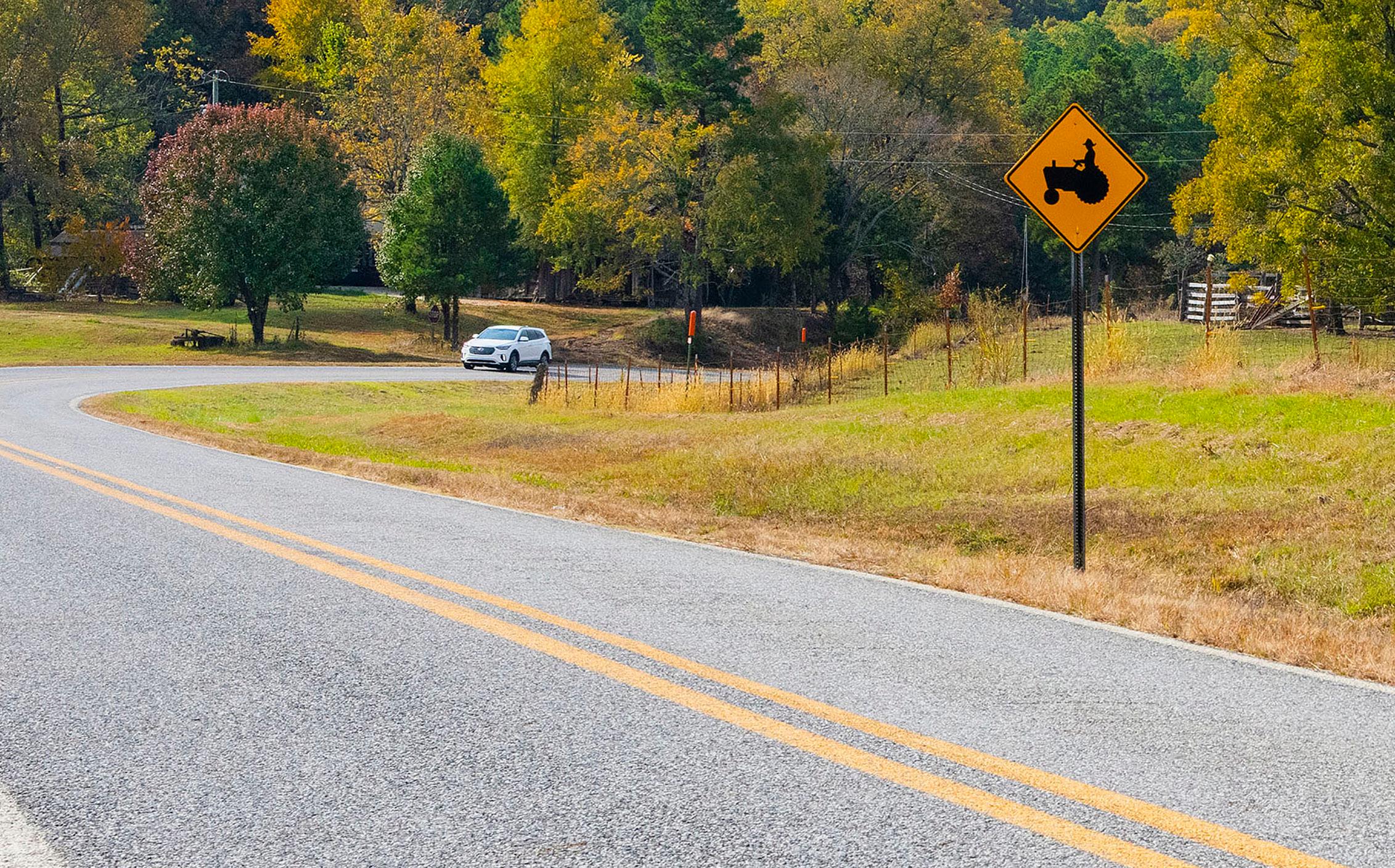
Good Roads works with our members to tell the story of the need for funding and financing to help all communities develop, build and maintain roads and bridges. This drives the local economy and makes the roads safer for all of us. We have corporate and individual membership rates available. The award-winning Good Roads magazine reaches more than 1,200 key stakeholders. If you want to put your message in front of an elite audience of state legislators, mayors, county judges, Good Roads members, engineers and the companies that build roads and bridges, this is the best way to do it. This is the only in-state publication that offers you an easy way to reach this very specific audience.




Lawren Wilcox, PE, is Garver’s Bridge Practice Leader, but he knows his job goes beyond linking communities together. It’s about keeping commerce flowing and making people’s lives just a little easier. And by delivering critical transportation projects across the state, he’s helping to improve safety and create better connectivity in Arkansas.


